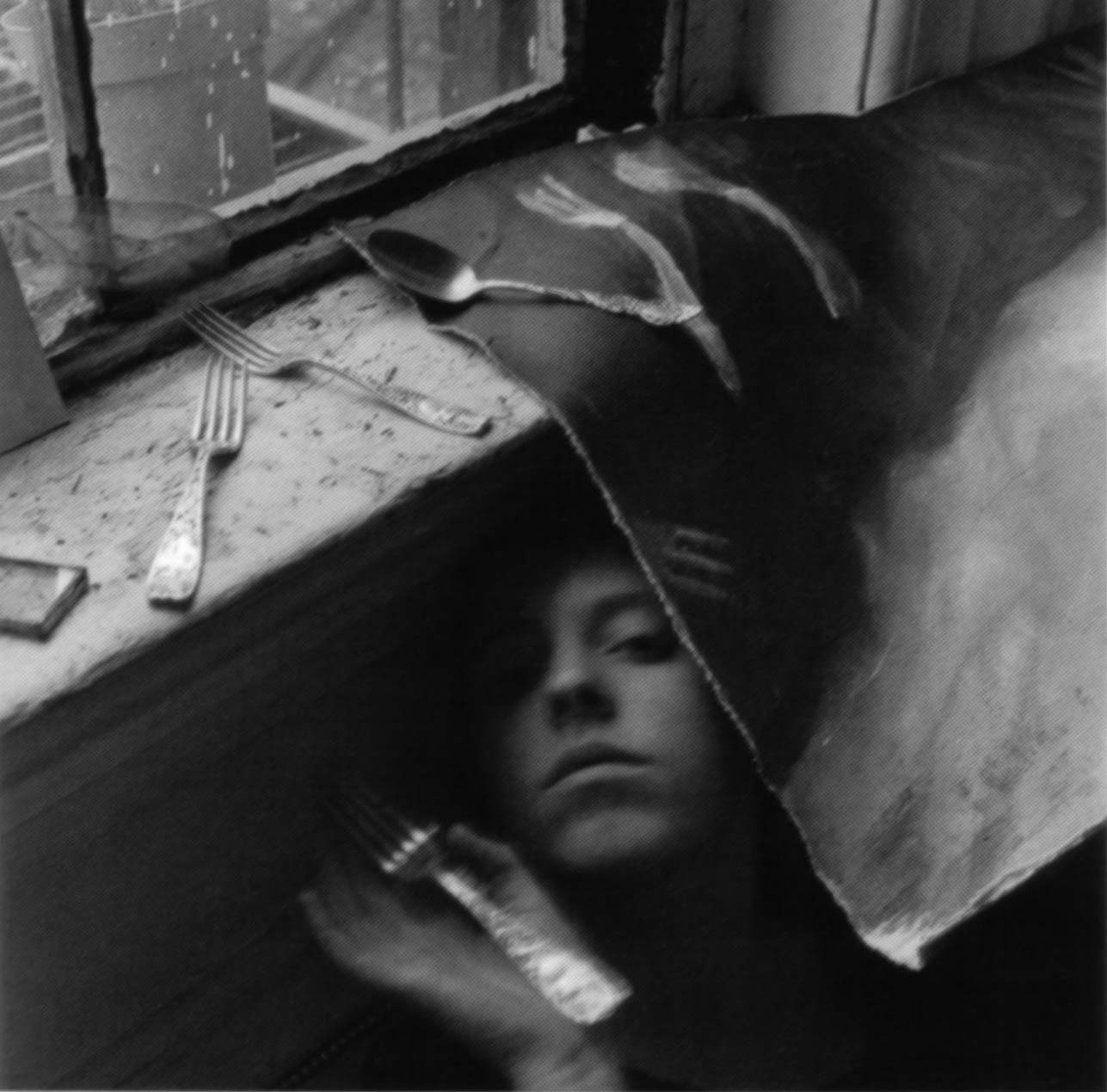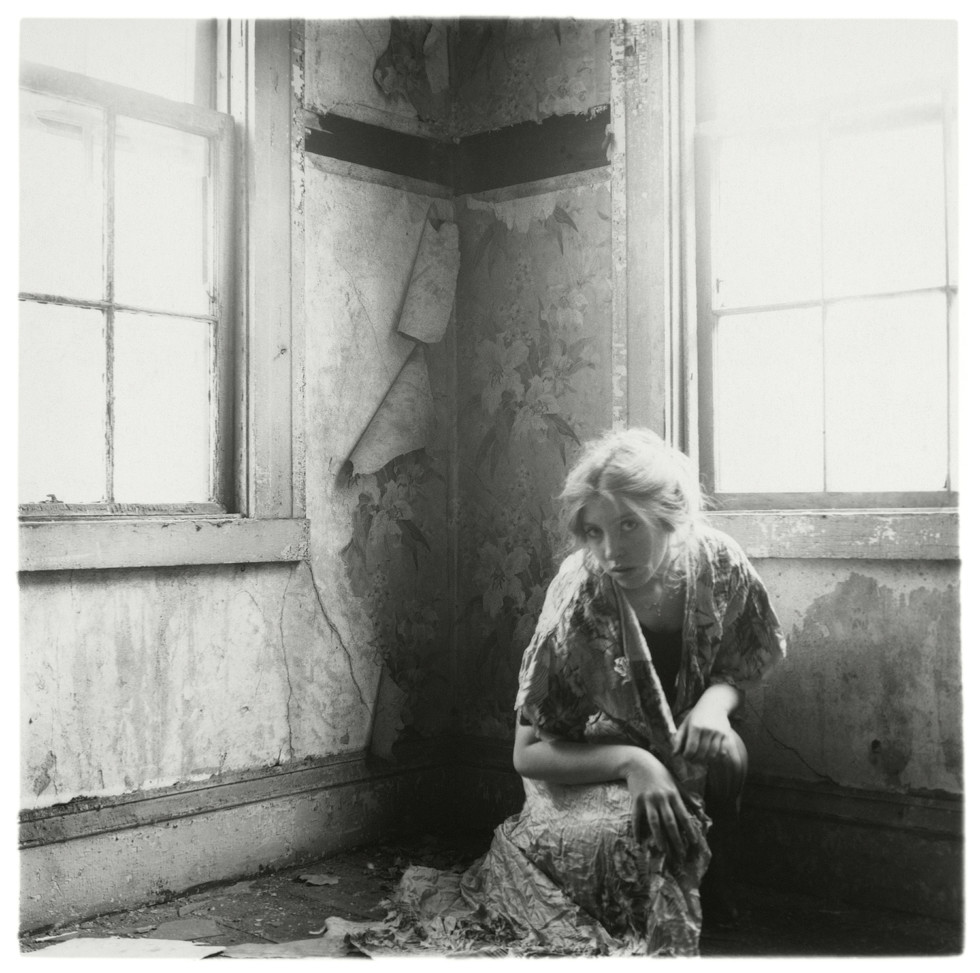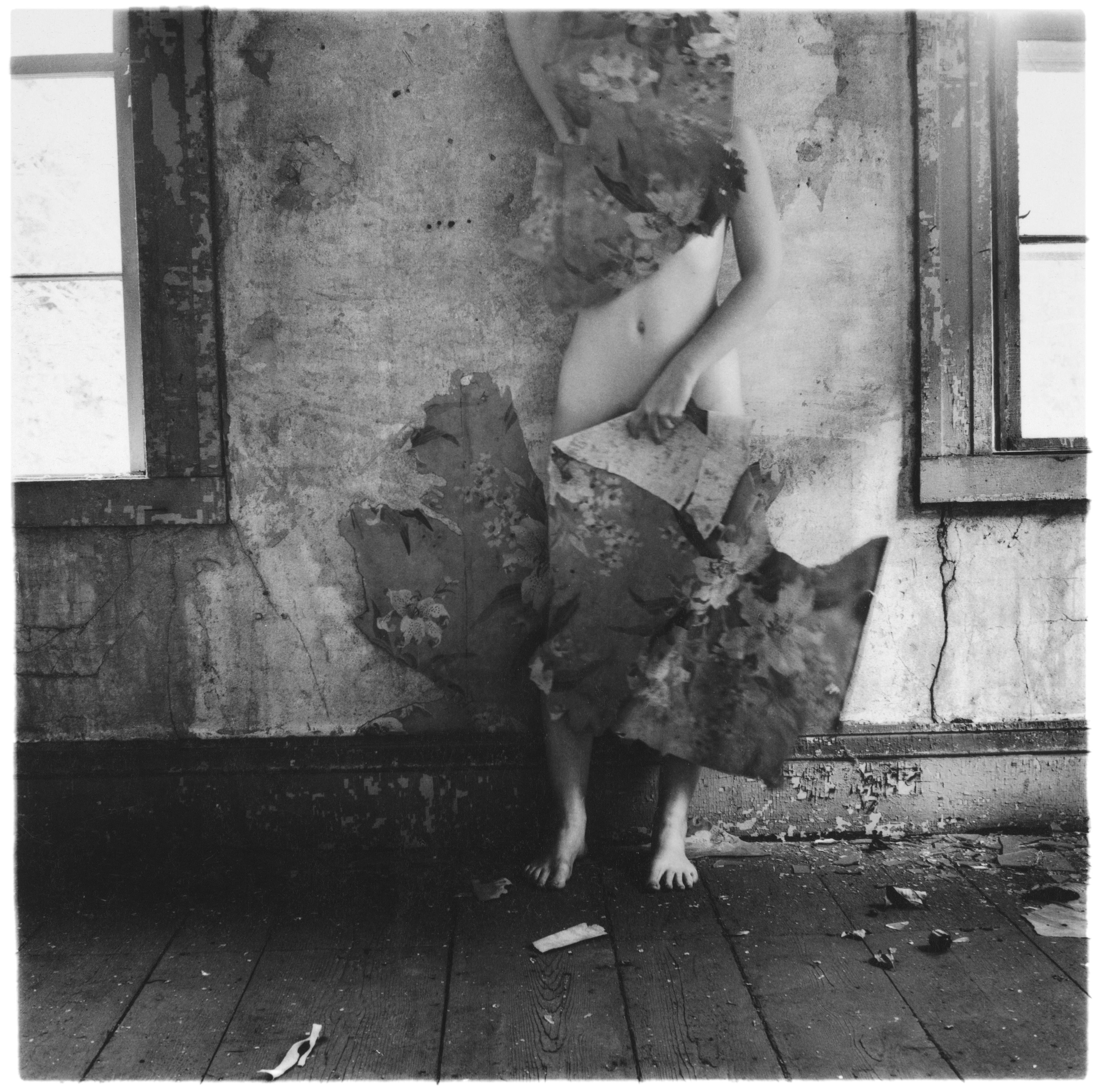

ولدت فرانشيسكا وودمان في دنفر في عام 1958. كانت ابنة اثنين من الفنانين الأمريكيين ، جورج وودمان ،
وهو رسام ومصور كان يشغل وظيفة تدريس في النقد الفني في جامعة كولورادو ، وبيتي وودمان ، وهو فنان خزفي متزايد الأهمية.
ترعرعت فرانشيسكا في مدينة بولدر التي تحيط بها الرسامون والمخرجون والنقاد ،
وكانت قريبة من شقيقها الأكبر تشارلز ، وهو نفسه فنان فيديو طموح.
Francesca Woodman
Jump to navigation Jump to search
| Francesca Stern Woodman | |
|---|---|

Self portrait of Woodman, c. 1977
|
|
| Born | April 3, 1958 Denver, Colorado, U.S. |
| Died | January 19, 1981 (aged 22) New York City, New York, U.S. |
| Cause of death | Suicide by jumping |
| Nationality | American |
| Education | Boulder High School |
| Alma mater | Rhode Island School of Design |
| Occupation | Photographer |
Francesca Stern Woodman (April 3, 1958 – January 19, 1981) was an American photographer best known for her black and white pictures featuring either herself or female models.
Many of her photographs show women, naked or clothed, blurred (due to movement and long exposure times), merging with their surroundings, or whose faces are obscured.
Her work continues to be the subject of much critical acclaim and attention, years after she died by suicide at the age of 22, in 1981.[1][2][3][4][5]
Life
Woodman was born in Denver, Colorado to artists George Woodman and Betty Woodman (Abrahams).[6][7] Her mother is Jewish and her father is from a Protestant background.[8] Her older brother, Charles, later became an associate professor of electronic art.[9]
Woodman took her first self portrait at age thirteen and continued photographing herself until her death.[10] She attended public school in Boulder, Colorado, between 1963 and 1971, except for second grade, which she attended in Italy, where the family spent many summers between school years. She began high school in 1972 at Abbot Academy, a private Massachusetts boarding school. There, she began to develop her photographic skills and became interested in the art form. Abbot Academy merged with Phillips Academy in 1973; Woodman graduated from the public Boulder High School in 1975.[7] Through 1975, she spent summers with her family in Italy[11][7] in the Florentine countryside, where the family lived on an old farm.[12]
Beginning in 1975, Woodman attended the Rhode Island School of Design (RISD) in Providence, Rhode Island. She studied in Rome between 1977 and 1978 in a RISD honors program. Because she spoke fluent Italian, she was able to befriend Italian intellectuals and artists.[13] She returned to Rhode Island in late 1978 to graduate from RISD.[11][7]
Woodman moved to New York City in 1979. After spending the summer of 1979 in Stanwood, Washington[14] whilst visiting her boyfriend at Pilchuck Glass School, she returned to New York “to make a career in photography.” She sent portfolios of her work to fashion photographers, but “her solicitations did not lead anywhere”.[15] In the summer of 1980, she was an artist-in-residence at the MacDowell Colony in Peterborough, New Hampshire.[15][7]
In late 1980, Woodman became depressed due to the failure of her work to attract attention and to a broken relationship.[16] She survived a suicide attempt in the autumn of 1980, after which she lived with her parents in Manhattan.[17]
On January 19, 1981, Woodman died by suicide, aged twenty two, jumping out of a loft window of a building on the East Side of New York City.[15][7] An acquaintance wrote, “things had been bad, there had been therapy, things had gotten better, guard had been let down”.[18] Her father has suggested that Woodman’s suicide was related to an unsuccessful application for funding from the National Endowment for the Arts.[19]
Works
Photographs, 1972–1980
Although Woodman used different cameras and film formats during her career, most of her photographs were taken with medium format cameras producing 2-1/4 by 2-1/4 inch (6×6 cm) square negatives.[20][21] Woodman created at least 10,000 negatives, which her parents now keep.[22] Woodman’s estate, which is managed by Woodman’s parents,[23] consists of over 800 prints,[7] of which only around 120 images had been published or exhibited as of 2006.[24] Most of Woodman’s prints are 8 by 10 inches (20 by 25 cm) or smaller, which “works to produce an intimate experience between viewer and photograph”.[25]
Many of Woodman’s images are untitled and are known only by a location and date.
Videos, 1975–1978
At RISD, Woodman borrowed a video camera and VTR[26] and created videotapes related to her photographs in which she “methodically whitewashes her own naked body, for instance, or compares her torso to images of classical statuary.”[27] Some of these videos were displayed at the Helsinki City Art Museum in Finland and the Marian Goodman Gallery in New York in 2004;[28] the Cisneros Fontanals Art Foundation in Miami in 2005;[27] the Tate Modern in London in 2007–2008;[29] and the San Francisco Museum of Modern Art in 2011 (in an exhibition which will travel to the Solomon R. Guggenheim Museum in 2012).[5] In the 2011–2012 exhibitions, the selected video works, each 23 seconds to 3 minutes 15 seconds in length, were entitled “‘Francesca’ x 2,” “Sculpture,” “Corner,” “Trace,” and “Mask.”[30]
Some Disordered Interior Geometries (1981 book)
Woodman created a number of artist’s books, such as Portrait of a Reputation, Quaderno dei Dettati e dei Temi (Notebook of Dictations and Compositions), Quaderno (also known as Quaderno Raffaello), Portraits Friends Equasions, and Angels, Calendar Notebook.[31][32][33] However, the only artist’s book containing Woodman’s photographs that was published during her lifetime was Some Disordered Interior Geometries.[34] Released in January 1981 shortly before Woodman’s death, it is 24 pages in length and is based upon selected pages from an Italian geometry exercise book. On the pages, Woodman had attached 16 photographs and had added handwriting and white correction fluid. A study of the book notes that Woodman occasionally re-drew a form “for emphasis or delight.”[35] A reproduction of the book’s original spreads shows purple-pink covers, pages which vary slightly in color, and traces of pink on several pages.[4] Although the published version of the book has purple-pink covers, the interior pages are printed using only black, white, and shades of gray.[34]
In 1999, a critic was of the opinion that Some Disordered Interior Geometries was “a distinctively bizarre book… a seemingly deranged miasma of mathematical formulae, photographs of herself and scrawled, snaking, handwritten notes.”[36] An acquaintance of Woodman wrote in 2000 that it “was a very peculiar little book indeed,” with “a strangely ironic distance between the soft intimacy of the bodies in the photographs and the angularity of the geometric rules that covered the pages.”[18] A 2006 essay described the book as “a three-way game that plays the text and illustrations for an introduction to Euclid against Woodman’s own text and diagrams, as well as the ‘geometry’ of her formal compositions,”[37] while a 2008 article found the book “poetic and humorous, analytical and reflexive.”[35] A 2010 article on Woodman called the book “original and enigmatic,”[38] and a 2010 review stated of the book that “we are the richer for it.”[39]
Posthumous recognition
Exhibitions and books
Woodman had only a few exhibitions during her life, some of which have been described as “exhibitions in alternative spaces in New York and Rome.”[40] There were no known group or solo exhibitions of her work between 1981 and 1985, but numerous exhibitions each year since then.[41][42] Among her major solo exhibitions were:
- 1986–1988: Francesca Woodman, photographic work.[1] Traveled to Hunter College Art Gallery, New York, NY; Wellesley College Museum, Wellesley, MA; University of Colorado Fine Arts Gallery, Boulder, CO; UCI Fine Arts Gallery, University of California, Irvine, CA; and Krannet Art Museum, Champaign, IL.[3][41][42]
- 1992–1993: Francesca Woodman, photographische arbeiten (photographic works).[2] Traveled to Shedhalle, Zürich, Switzerland; Westfälischer Kunstverein, Münster, Germany; Kulturhuset, Stockholm, Sweden; Suomen Valokuvataiteen Museo SÄÄTIÖ, Helsinki, Finland; DAAD Galerie, Berlin, Germany; and Galleri F15 Alby, Moss, Norway.[3][41][42]
- 1998: “l’artiste et la représentation de soi, Francesca Woodman, Rencontres d’Arles festival.
- 1998–2002: Francesca Woodman.[3] Traveled to Fondation Cartier pour l’art contemporain, Paris, France; Kunsthal, Rotterdam, The Netherlands; Belém Cultural Center, Lisbon, Portugal; The Photographers’ Gallery, London, United Kingdom; Centro Cultural Tecla Sala, L’Hospitalet, Barcelona, Spain; Carla Sozzani Gallery, Milan, Italy; The Douglas Hyde Gallery, Dublin, Ireland; and PhotoEspana, Centro Cultural Conde Duque, Madrid, Spain.[41][42]
- 2000: Francesca Woodman: Providence, Roma, New York.[43] Palazzo delle Esposizioni, Rome.[41][42]
- 2009–2010: Francesca Woodman.[44] Traveled to Espacio AV, Murcia, Spain; sms contemporanea, Siena, Italy; and Palazzo della Ragione, Milan, Italy.[45]
- 2011–2012: Francesca Woodman. San Francisco Museum of Modern Art, San Francisco, CA; and Solomon R. Guggenheim Museum, New York, NY.[46][47][48] Many had never been on display before.[23]
- 2015–2017: On Being an Angel.[49] Traveled to Moderna Museet, Stockholm; Foam Photography Museum, Amsterdam; Fondation Henri Cartier-Bresson, Paris; Moderna Museet, Malmo; Finnish Museum of Photography, Helsinki.
Besides catalogues of the aforementioned traveling solo exhibitions and catalogues of solo exhibitions that did not travel, notable books by and about Woodman include:
- A monograph published in 2006 by Phaidon Press.[4]
- A 2010 book examining the relevance of Woodman’s photography as a way of understanding Kant’s theory of the sublime.[50]
- Francesca Woodman’s Notebook, which was released in 2011.[51] It contains a facsimile of an Italian school exercise book to which Woodman added photographs, as well as an afterword by Woodman’s father.[52] This book, also known as Quaderno or Quaderno Rafaello, has been described as “both an urgent missive to a lover and a playful sexual summons.”[53]
- Francesca Woodman’s diazotypes and other later works are examined in a 2016 book by Claire Raymond.[54]
The films The Fancy and The Woodmans
In 2000 an experimental video The Fancy, by Elisabeth Subrin, examined Woodman’s life and work, “pos[ing] questions about biographical form, history and fantasy, female subjectivity, and issues of authorship and intellectual property.”[55][56] Reviewers noted that the video juxtaposes “formalism, biography, and psychoanalysis”[57] and “hints at conspiracy, calling attention to the Woodman family’s unwillingness to make the bulk of her body of photography available….”[58]
A feature-length documentary The Woodmans, was released theatrically by Lorber Films[59][60] on the thirtieth anniversary of her death, 18 January 2011. The director “had unrestricted access to all of Francesca’s photographs, private diaries, and experimental videos”.[61] Although the film won “Best New York Documentary” at the Tribeca Film Festival, Woodman’s parents decided not to attend the premiere.[62] Reactions to the film have been largely favorable. On the film review site Rotten Tomatoes, 94% of 17 critics’ reviews were positive, and 83% of 793 user ratings were positive.[63] It was broadcast on the PBS series Independent Lens on December 22, 2011.[61][64]
Popular opinion
Public opinion has generally been favorable towards Woodman’s work. At the 1998 exhibition in Paris, many people had “strong reactions” to her “interesting” photographs.[16] A number of people have found Woodman’s individual photos (for example “Self-portrait at 13”[65]) or her photography in general[66] inspirational.
Influences
Among other factors, critics and historians have written that Woodman was influenced by the following literary genre, myth, artistic movement, and photographers:
- Gothic fiction. She is reported to have identified with Victorian heroines.[67] Many of the stories feature a female figure that is often forced into solitude, then they turn mad. The Gothic style is full of symbols of tombs, mirrors, demons and angels.[68]
- The myth of Apollo and Daphne, as evidenced by photographs in which Woodman is entangled in tree roots or wears birch bark on her arms.[69]
- Surrealism.[70][71][72] She studied surrealism immensely and studied the workings of Duane Michaels.[68] For example, Woodman “followed the movement’s tradition of not explaining work”[16] and demonstrated a “desire to crack the code of appearances.”[73]
- André Breton and in particular his Nadja (novel) of 1928. In a 1979 interview with Roberta Valtorta, Woodman is reported as saying “Vorrei che le parole avessero con le mie immagini lo stesso rapporto che le fotografie hanno con il testo in Nadja di André Breton” (“I would like words to have the same relationship with my images as the photographs have with the text in Nadja by André Breton”.[74] Translated by Dunhill.[75])
- Man Ray (e.g., a series of his photographs of Meret Oppenheim, and his surrealist works).[7][32]
- Duane Michals.[76][7] Woodman’s and Michal’s work share features such as blurring, angels, and handwriting in common.[77]
- Deborah Turbeville.[78][7] Woodman had “admired” Turbeville’s work,[15] and had compiled an artist’s book for Turbeville (Quaderno Rafaello) which contained a written request for the older photographer to telephone her.[79]
- Woodman was exposed to the symbolic work of Max Klinger whilst studying in Rome from 1977 to 1978 and his influence can clearly be seen in many photographic series’, such as Eel Series, Roma (1977–78) and Angel Series, Roma (1977). In combining performance, play and self-exposure, Woodman’s photographs create extreme and often disturbing psychological states. In concealing or encrypting her subjects she reminds the viewer that photographs flatten and distort, never offering the whole truth about a subject.
References
- Gabhart 1986.
- Lux 1992.
- Chandès 1998.
- Townsend 2006.
- Keller 2011.
- Chandès 1998, p. 4.
- MacMillan, Kyle (December 14, 2006). “Francesca Woodman’s haunting vision”. Denver Post. Retrieved April 25, 2018.
- Johnson, Ken (March 15, 2012). “‘Francesca Woodman’ at Guggenheim Museum”. The New York Times.
- Video works Charles Woodman, photographs Francesca Woodman, May 6 – June 16, 2005. Notes for an exhibition at Shirley-Jones Gallery, Yellow Springs, Ohio. Accessed 2007-09-07.
- “Francesca Woodman – 50 Artworks, Bio & Shows on Artsy”. www.artsy.net. Retrieved 2018-04-05.
- Chandès 1998, p. 154.
- Tellgren, Anna (2016). “Francesca Woodman: On being an angel” (PDF). Moderna Museet. pp. 9–16. Retrieved April 25, 2018.

- Chandès 1998, pp. 26–30, 154.
- Solomon-Godeau 2017, p. 177.
- Chandès 1998, p. 155.
- Riding, Alan. Pictures, perhaps, of her despair: a young photographer’s work may or may not hold clues to her suicide. New York Times, 1998-05-17.
- Gumport, Elizabeth (January 24, 2011). “The Long Exposure of Francesca Woodman”. New York Review of Books. Retrieved December 29, 2016.
- Davison, Peter. Girl, seeming to disappear. Atlantic Monthly, 2000 May;285(5):108–111.
- Hoberman, J. (January 19, 2011). “Photographer Francesca Woodman Gets Her Close-Up in a Haunting Family Study”. Village Voice. Retrieved November 16, 2011.
- Townsend 2006, p. 9.
- Keller 2011, p. 179.
- Wood, Gaby. The lady vanishes. The Observer, 1999 July 25.
- Loos, Ted (December 1, 2011). “Sharing a Guarded Legacy”. New York Times. Retrieved December 21, 2012.
- Townsend 2006, p. 6.
- Simon, Jane (2010). “An intimate mode of looking: Francesca Woodman’s photographs”. Emotion, Space and Society. 3: 28–59. doi:10.1016/j.emospa.2010.01.013.
- Townsend 2006, p. 27.
- Robinson, Walter (December 12, 2005). “Maximum Miami”. ArtNet Magazine. Retrieved December 10, 2016.
- “Francesca Woodman, October 12 – November 13, 2004”. Marian Goodman Gallery. Archived from the original on November 16, 2007. Retrieved January 9, 2017.
- Francesca Woodman (Room 8). Tate Modern, 2007.
- Blessing 2011, pp. 196–203.
- Townsend 2006, p. 4.
- Riches, Harriet. Disappearing Act: Francesca Woodman’s Portrait of a Reputation. Oxford Art Journal 2004;27(1):95–113.
- Dunhill 2012.
- Woodman, Francesca (1981). Some disordered interior geometries. Philadelphia: Synapse Press. OCLC 11308833.
- Dunhill, Alison. Dialogues with Diagrams. re•bus, 2008 Autumn/Winter;2.
- Henshall, John. Fatal attraction. New Statesman, 1999 August 23.
- Townsend 2006, p. 239.
- Somerville, Kris (2010). “Clues to a Lost Woman: The Photography of Francesca Woodman”. The Missouri Review. 33 (3): 79–91. doi:10.1353/mis.2010.0043.
- Spence, Rachel. Francesca Woodman, Palazzo della Ragione, Milan. Financial Times, 2010-08-02. Accessed 2011-11-15.
- Baker, George; Daly, Ann; Davenport, Nancy; Larson, Laura; and Sundell, Margaret (2003). “Francesca Woodman Reconsidered: A Conversation with George Baker, Ann Daly, Nancy Davenport, Laura Larson, and Margaret Sundell”. Art Journal. 62 (2). JSTOR 3558506.
- “Francesca Woodman”. Marian Goodman Gallery. 2004. Archived from the original on February 27, 2009. Retrieved September 7, 2007.
- “Biography for Francesca Woodman” (PDF). Victoria Miro Gallery. 2007. Retrieved September 7, 2007.[permanent dead link]
- Oliva, Achille Bonito (2000). Francesca Woodman: Providence, Roma, New York. Roma: Castelvecchi arte. ISBN 88-8210-192-4. OCLC 45108542.
- Tejeda, Isabel (2009). Francesca Woodman: Retrospectiva = Retrospective. Murcia, Spain: Espacio AV. ISBN 978-84-96898-42-4.
- Pelloso, Giovanni (2010-07-13). “I ritratti e i misteri di Francesca Woodman”. Corriere della Sera (in Italian). Retrieved 2011-11-07.
- Ho, Alexander (November 4, 2011). “Retrospective: Looking Back on Francesca Woodman’s Prolific Career”. Time. Archived from the original on November 5, 2011. Retrieved 2011-11-07.
- Baker, Kenneth (2011-11-12). “Francesca Woodman’s Foreboding Essence Timeless”. San Francisco Chronicle. Retrieved 2011-11-12.
- Bowman, Cathy (2011-11-07). “Francesca Woodman Exhibit Displays Haunting Beauty”. San Francisco Examiner. Archived from the original on 2012-10-11. Retrieved 2011-11-12.
- Tellgren, Anna (2015). Francesca Woodman: Retrospectiva = Retrospective. Stockholm, Sweden: Moderna Museet. ISBN 978-38-63357-50-4.
- Raymond, Claire (2010). Francesca Woodman and the Kantian sublime. Farnham, Surrey and Burlington, VT: Ashgate. ISBN 978-0-7546-6344-7.
- Woodman, Francesca (2011). Francesca Woodman: On Being an Angel. Milan: Silvana. ISBN 978-88-366-2117-0.
- International Center of Photography Store. Francesca Woodman’s Notebook. Archived 2012-06-07 at the Wayback Machine. Accessed 2011-11-16.
- Dunhill, Alison (2012). “Quaderno Raffaello: Anticipation and Delight” (PDF).
- Raymond, Claire (2016). Francesca Woodman’s Dark Gaze. Farnham, Surrey and Burlington, VT: Ashgate. ISBN 978-14-724-5712-7.
- Subrin, Elisabeth. The Fancy (video). Chicago: Video Data Bank (distributor), 2000. OCLC 45301667.
- Video Data Bank page on The Fancy. Archived 2007-04-30 at the Wayback Machine. Accessed 2007-09-07.
- Greene, Rachel. Elisabeth Subrin, The Fancy (review). Bomb 2001 Fall;77:22.
- Armour, Nicole. Disappearing acts. Film Comment 2000 Nov/Dec;36(6):55-57.
- Kino Lorber. The Woodmans. Directed by C. Scott Willis. A Lorber Films Release. 2010. Accessed 2011-11-15.
- The Woodmans
- Independent Television Service. The Woodmans, the Haunting Story of Late Photographer Francesca Woodman and Her Family, Premieres on PBS’s Independent Lens on Thursday, December 22, 2011 (press release). 2011-09-21. Accessed 2011-11-15.
- Messer, Ron. C. Scott Willis Interview THE WOODMANS – 2010 Tribeca Film Festival. Collider.com, 2010-05-10. Accessed 2011-11-15.
- The Woodmans (2010). RottenTomatoes.com. Accessed 2011-11-15.
- Public Broadcasting Service, Independent Lens §where it won the 2012 Emmy Award for Outstanding Arts & Culture Programming. The Woodmans. Accessed 2011-11-15.
- Moakley, Paul. Watch closely: Gigi Giannuzzi on Francesca Woodman. Photo District News, 2003 August.
- Gryphon’s Feather Studio blog entry, 2005 October 21. Archived 2006-11-26 at the Wayback Machine. Accessed 2007-09-07.
- Townsend 2006, pp. 20–27.
- “Francesca Woodman Biography, Art, and Analysis of Works”. The Art Story. Retrieved 2018-04-05.
- Tutter, Adele (2011). “Metamorphosis and the aesthetics of loss: II. Lady of the woods – The transformative lens of Francesca Woodman”. International Journal of Psychoanalysis: Early View (Online Version). doi:10.1111/j.1745-8315.2011.00457.x.
- Gabhart 1986, p. 19.
- Conley, Katharine. A Swimmer Between Two Worlds: Francesca Woodman’s Maps of Interior Space. Journal of Surrealism and the Americas 2:2 (2008), 227–252.
- Rus, Eva. Surrealism and self-representation in the photography of Francesca Woodman. 49th Parallel: an Interdisciplinary Journal of North American Studies, Spring 2005. Accessed 2014-09-03.
- Chandès 1998, p. 18.
- Valtorta, Roberta. Francesca Woodman. Progresso Fotografico, 1979 October;86:10:46-50.
- Dunhill 2012, p. 8.
- Gabhart 1986, p. 54.
- Townsend 2006, pp. 29–30.
- Townsend 2006, pp. 30–31, 39–40.
- Keller 2011, p. 184.
Works cited
- Blessing, Jennifer (2011). “The Geometry of Time: Some Notes on Francesca Woodman’s Video”. In Keller, Corey. Francesca Woodman. San Francisco and New York: San Francisco Museum of Modern Art in association with D.A.P./Distributed Art Publishers. ISBN 978-1-935202-66-0.
- Chandès, Hervé, ed. (1998). Francesca Woodman. Paris and Zürich: Fondation Cartier pour l’art contemporain and Scalo. ISBN 3-931141-96-9. OCLC 40184932.
- Dunhill, Alison (2012). Almost A Square: The Photographic Books of Francesca Woodman and Their Relationship to Surrealism (Thesis). University of Essex Press.
- Gabhart, Ann (1986). Francesca Woodman, photographic work. Wellesley, MA: Wellesley College Museum. OCLC 13474131.
- Lux, Herman (1992). Francesca Woodman: Photographische arbeiten = Photographic works. Zürich: Shedhalle. ISBN 3-907830-01-6. OCLC 27972302.
- Keller, Corey, ed. (2011). Francesca Woodman. San Francisco and New York: San Francisco Museum of Modern Art in association with Distributed Art Publishers. ISBN 978-1-935202-66-0.
- Solomon-Godeau, Abigail (2017). Photography after Photography: Gender, Genre, History. Duke University Press. ISBN 978-0-822-37362-9.
- Townsend, Chris (2006). Francesca Woodman. London: Phaidon. ISBN 978-0-7148-4430-5. OCLC 76893694.
- Webb, Sarah E. (2003). “Epilogue: Mark Making, Writing, and Erasure”. In Frederickson, Kristen, and Sarah E. Webb. Singular Women: Writing the Artist. University of California Press. ISBN 0-520-23164-3.
Further reading
- Sundell, Margaret. “Vanishing Points: The Photography of Francesca Woodman.” In: de Zegher, Catherine, ed. (1996). Inside the visible: an elliptical traverse of 20th century art in, of, and from the feminine. Ghent: Les Editions La Chambre. ISBN 90-72893-18-2. OCLC 84213738.
- Buchloh, B H D; Betsy Berne (2004). Francesca Woodman, photographs, 1975–1980. New York: Marian Goodman Gallery. ISBN 0-944219-04-7. OCLC 57449808.
- Mellby, Julie. “Francesca Woodman.” In: Warren, Lynne, ed. (2006). Encyclopedia of twentieth-century photography. New York: Routledge. ISBN 978-1-57958-393-4. OCLC 60402034. Pages 1703–1705.
- Armstrong, Carol, “Francesca Woodman: A Ghost in the House of the ‘Woman Artist’.” In: Armstrong, Carol; Catherine de Zegher, eds. (2006). Women artists at the millennium. Cambridge, Mass: MIT Press. ISBN 0-262-01226-X.
- Cristofovici, Anca (2008). “Chapter 5, Performing Corpo-Realities”. Touching Surfaces: Photographic Aesthetics, Temporality, Aging. Amsterdam: Rodopi. pp. 157–192. ISBN 978-90-420-2513-4.
External links
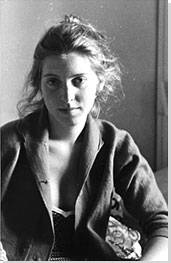
Francesca Woodman
American Photographer
Movements and Styles: Surrealism, Modern Photography, Dada and Surrealist Photography
Born: April 3, 1958 – Denver, Colorado
Died: January 19, 1981 – New York City

Table of contents
Synopsis
Key Ideas
Most Important Art
Biography
Influences and Connections
Resources
“I feel like I am floating in plasma. I need a teacher or a lover. I need someone to risk being involved with me. I am so vain and I am so masochistic.”
Synopsis
Francesca Woodman produced universally commanding and profound images from the age of thirteen. Born into a family of artists, ‘art’ was her first language. She experienced early exposure to a plethora of exemplary creative people along with countless potential historical, literary, and theoretical influences. Woodman worked with traditional photographic techniques but was consistently performative and experimental in her practice. Many of her works are multi-media, including drawings, selected objects, and sculptures within her photographs. Settings may vary from confined interiors to the expansive outdoors, but Woodman herself is always there. Typically the sole subject, and often naked, she can be found caught entwined within a landscape or edging out of the photographic frame. Interested in the limits of representation, the artist’s body is habitually cropped, endlessly concealed, and never wholly captured. Woodman was acutely aware of the evanescent nature of life and of living close to death. She positions the self as too limitless to be contained, and thus reveals singular identity as an elusive and fragmentary notion.
Key Ideas
Biography
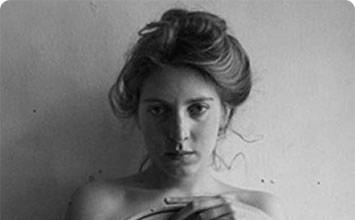
Childhood
Francesca Woodman was born in Denver in 1958. She was the daughter of two American artists, George Woodman, a painter and photographer who held a teaching post in art criticism at the University of Colorado, and Betty Woodman, an increasingly important ceramic artist. Growing up in Boulder, surrounded entirely by painters, filmmakers, and critics, Francesca was close to her older brother Charles, himself an aspiring video-artist.




